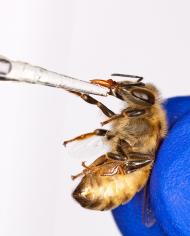Specially trained canines may be used to detect citrus greening in orchards.
Tellus Articles
ARS researchers are helping prevent the spread of citrus pathogens.
Trap controls Asian citrus psyllids in citrus trees growing in residential and commercial landscapes.
One of the most aggressive invasive weeds in the southeastern United States may have met its match.
ARS researchers are working to understand the impact of a changing climate on bee health.
An ARS scientist in the Pacific Northwest has joined the hunt for the infamous Asian giant hornet.
New plant contains twice the amount of artemisinin used to manufacture therapies against malaria.
ARS researchers are working to fight the spread of Lyme disease through the control of deer ticks.
ARS launches its first-ever Hackathon against the most challenging agricultural issues.
Female monarchs prefer some milkweed species over others.
ARS Electron and Confocal Microscopy Unit helped identify mites found in the highlands of Peru.
ARS entomologist is developing microbial pesticides for the effective control of mosquitoes.
Cute as Can Bee! Learn more ARS honey bee research.
The ARS Bee Research Lab maintains a Pollinator Garden as an educational tool.
ARS research finds cedarwood oil has potential as a natural pest-control agent and wood treatment.
Hunting for natural enemies of the red imported fire ant is paying off.
By tapping into the vibrational signals they use as mating calls.
ARS scientists play an essential role in bringing products to your grocery store shelves.
Scientists with the USDA are studying ways to keep honeybees stress-free and healthy.
The seeds of a purple-flowered annual known as cuphea could be the source of another insect repellent.
In ARS laboratory studies essential oils in Italian honeysuckle killed 100 percent of mosquito larvae.
An ARS entomologist is focused on finding natural ways to control stink bugs.
The emerald ash borer is destroying ash trees, which are used to make baseball bats.
There’s surprising news about a pest that’s the main culprit in global honey bee colony losses.
The spotted lanternfly, first sighted in Pennsylvania, is an invasive pest to the United States.


























